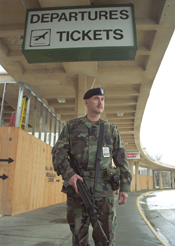|
Destination anticipation
Students encounter new airport security during holiday travel
by Allison Jenks
Scroll Staff
 |
| Staff Sergeant Bailey of the 1st 145 Field Artillery of the National Guard patrols the entrance to the Idaho Falls airport terminal. Armed guards are becoming commonplace at airports due to the heightened security across the nation. James Ricks / Scroll |
|
As students traveled around the country during Christmas break, there was excitement and anticipation for a wonderful holiday and a new semester.
Unfortunately, there was also the fear of disaster on the minds of many, especially those charged with the safety of millions.
A record 87 percent of all travel was done by automobile this holiday season, according to American Automobile Association.
The organization attributes the high numbers of automobile travelers to the terrorist attacks and fear that has kept people on the ground and closer to home.
But things are changing. The metal detectors of yesterday have been replaced with low-powered X-rays and computers that can sense trace amounts of key elements in explosives.
Government officials and airport directors have been implementing new security programs to make passengers feel more secure in their travels, and many of these fears should be lessened because of the massive increases in security at airports all over the country.
There are 180 bomb-sniffing dogs patrolling 39 airports. Guards are conducting random X-ray searches of people’s shoes after the incident in which Richard Reid hid bombs in his tennis shoes and boarded an airplane undetected. Some people receive old-fashioned pat-downs when they step through the security gates.
A controversial search method is the electronic strip search where low-level X-rays penetrate clothing for a visual weapons search.
There are also walk-through bomb detectors that puff air onto passengers. The air puffs can dislodge trace amounts of explosives, and then sensors trap the expelled dust for analysis.
Another safety program recently established is the Federal Air Marshal program. The Federal Aviation Administration said it has have received about 100,000 applications for marshal positions since Sept. 11. The FAA also said that it keeps the program secretive because that is an integral part of its being effective. Passengers will never know if there is an air marshal on their flight.
Many students traveled through the Salt Lake International Airport this holiday season. Captain Willard Arscott pilots flights from this airport to San Francisco, China and Japan.
Many of these new security measures are now at the Salt Lake airport, he said.
National Guard soldiers armed with M-16 combat rifles guard security portals and the baggage claim and can be seen throughout the airport. If the metal detector’s alarm sounds, the passenger who set it off must have their shoes X-rayed and an all-over pat down and manual metal detector test.
BYU-I student Sarah Scott traveled through the Charleston, Dallas-Fort Worth and Salt Lake airports.
“In Charleston, I thought it was strange because they didn’t even ask for ID when I picked up my ticket. In Salt Lake, I arrived for my 8:45 a.m. flight four hours early and spent the entire time in security lines. I had my bag X-rayed and searched, my shoes tested and an X-ray wand ran over my legs. Dogs were everywhere, and the security was even tighter in the Dallas-Fort Worth airport,” she said.
All material posted on Scroll eNews is property of BYU-Idaho Scroll.
Contact scrollinternet@byui.edu with comments or problems.
|

